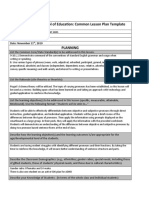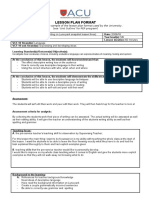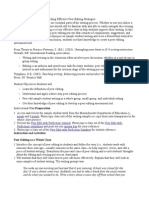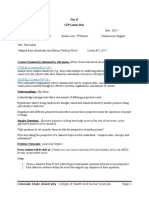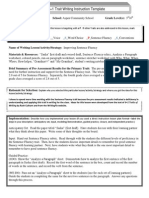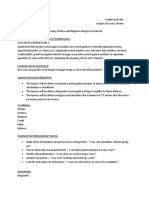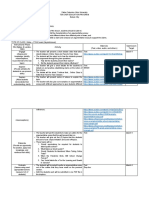CEP Lesson Plan Form: Colorado State University College of Health and Human Sciences Page 1
CEP Lesson Plan Form: Colorado State University College of Health and Human Sciences Page 1
Uploaded by
api-277220385Copyright:
Available Formats
CEP Lesson Plan Form: Colorado State University College of Health and Human Sciences Page 1
CEP Lesson Plan Form: Colorado State University College of Health and Human Sciences Page 1
Uploaded by
api-277220385Original Title
Copyright
Available Formats
Share this document
Did you find this document useful?
Is this content inappropriate?
Copyright:
Available Formats
CEP Lesson Plan Form: Colorado State University College of Health and Human Sciences Page 1
CEP Lesson Plan Form: Colorado State University College of Health and Human Sciences Page 1
Uploaded by
api-277220385Copyright:
Available Formats
CEP Lesson Plan Form
Teacher: Myers
School: Blevins Middle School
Date: 12. 7. 2015
Grade Level: 7
Content Area: English
Title: Shakespeares Got Rhythm
Content Standard(s) addressed by this lesson:
Lesson #: 5 of 10
Content Area: Reading, Writing, and Communicating
Standard: 2. Reading for All Purposes
Prepared Graduates:
Seek feedback, self-assess, and reflect on personal learning while engaging with increasingly more difficult texts
Grade Level Expectation: Seventh Grade
Inquiry Questions: What is poetic meter? What is the definition of Iambic Pentameter? Why did Shakespeare use
Iambic Pentameter?
Concepts and skills students master: Literary elements, characteristics, and ideas are interrelated and guide
the comprehension of literary and fictional texts
Evidence Outcomes: ii. Analyze the structure an author uses to organize a text, including how the major sections
contribute to the whole and to the development of the ideas. (CCSS: RI.7.5)
Every student will be able to:
Students will be able to define and apply Iambic Pentameter using Shakespeares Sonnet 18.
Assessment of Evidence Outcomes:
Formative Review: Students will complete a handout in which they
have to identify the various literary devices in music. The song will play and they have a certain amount of time to
identify the device. There is a peer-assessment part of this: students will write on a whiteboard their answer and
then must check with their teammates to determine whether the answer is correct before they hold up their paddle.
Colorado State University College of Health and Human Sciences
Page 1
CEP Lesson Plan Form
Alternative Formative Assessment: Students will complete a handout in which they must identify the stressed
and unstressed syllables in sonnet 18, with a partner.
Planned Lesson Activities
Activity Name
Shakespeares Got Rhythm
Approx. Time
80 minutes.
Anticipatory
Set
Warm Up Quote:
So long as men can breathe or eyes can see,
So long lives this and this gives life to thee. ~ William Shakespeare
Teaching/
Presentation:
(Select the most
appropriate
teaching model.)
-direct
instruction
-presentation
model
-concept
teaching
-cooperative
1. A. Say the quote out loud.
B. Sing the quote.
C. Interpret the quote.
Includes: Input, Modeling and Checking for Understanding
1. Input: You Tube Music Sections. Video: Iambic Pentameter <
https://youtu.be/I5lsuyUNu_4>
2. Modeling: Teacher will model how to label iambic pentameter using student names on the
white board and then will show them how to label the first two lines of Sonnet 18 on the
DocCam.
3. Checking for Understanding: Teacher will walk around room and make sure students are
on the right track. Students will also be self-checking with their partner.
4. Questioning Strategies: (knowledge, comprehension, application, analysis, evaluation)
Colorado State University College of Health and Human Sciences
Page 2
CEP Lesson Plan Form
learning
-inquiry
Teaching
Strategy:
Guided Practice
&
Differentiation
Teaching
Strategy:
(Independent
Practice)
Closure
Materials
Teacher will guide students during literary device review on how to play the game and complete
the activity. (20 minutes)
Teacher will show students how to label iambic pentameter on a sonnet. (10 minutes)
Quote Interpretation. (5 minutes)
Students will identify literary devices in music. (20 minutes)
Students will be working on their individual sonnets but with a partner. (30 minutes)
Review iambic pentameter briefly in a call and response fashion. (5 minutes)
Smart Board
Internet
You Tube videos for songs listed on the handouts
White Board
Doc Cam
Writing Utensil
Colorado State University College of Health and Human Sciences
Page 3
CEP Lesson Plan Form
Accommodatio
ns
&
Modifications
Assessment
To modify: all handouts have been modified for lower level students
To extend: the lesson has already been extended by creating a sort of game out of the musical
activity. The sonnet activity was equally difficult for most students.
Formative Review: Students will complete a handout in which they have to identify the
various literary devices in music. The song will play and they have a certain amount of time to
identify the device. There is a peer-assessment part of this: students will write on a whiteboard
their answer and then must check with their teammates to determine whether the answer is
correct before they hold up their paddle.
Alternative Formative Assessment: Students will complete a handout in which they must
identify the stressed and unstressed syllables in sonnet 18, with a partner.
Colorado State University College of Health and Human Sciences
Page 4
CEP Lesson Plan Form
Post Lesson Reflection
1. To what extent were lesson objectives achieved? The added
literary device review really helped students comprehend the literary
devices. The sonnet activity went extremely well but some students
struggled.
2. What changes, omissions, or additions to the lesson would
you make if you were to teach again? I think it could use another
sonnet activity.
3. What do you envision for the next lesson? I chose to use the
extension I mentioned in the unit outline. It should help with the
understanding of the language and will enable the class to begin the
play.
Colorado State University College of Health and Human Sciences
Page 5
CEP Lesson Plan Form
Colorado State University College of Health and Human Sciences
Page 6
CEP Lesson Plan Form
Direct Instruction
Describe or
demonstrate the
lesson introduction
including how you
establish set (i.e.,
prepare students to
learn) and how you
share the lesson
outcome.
Demonstrate or list
the task analysis of
the skill or procedure
(i.e., define precisely
what the learners
need to do)
Describe or
demonstrate your
modeling of the skill
or procedure.
Describe or
demonstrate guided
practice including the
second (or third)
example and then
address your method
to check for
understanding (i.e.,
how you assess
student learning
before moving to the
next stage). Include
Presentation
Model
Describe or
demonstrate the
lesson introduction
including how you
establish set (i.e.,
prepare students to
learn) and how you
share the lesson
outcome.
Concept Teaching
Describe or
demonstrate an
advance organizer.
Describe or
demonstrate all of
the critical attributes
of the concept,
identify the class or
category to which the
concept belongs.
Describe, picture or
demonstrate learning
materials and
activities specific to
the options of this
model (e.g.,
explaining links and
examples; ruleexample-rule;
signposts and
transitions). Two or
more of the teaching
and learning
activities are rich and
engaging.
Describe, list or
demonstrate one or
more questions, or a
discussion structure
Describe or
demonstrate the
lesson introduction
including how you
establish set (i.e.,
prepare students to
learn) and how you
share the lesson
outcome.
Describe or
demonstrate a clear
progression of
examples and nonexamples; deduction
is illustrated through
the early definition of
the concept;
induction is
illustrated through
definition of the
concept late in the
activities.
Describe or
demonstrate the
Colorado State University College of Health and Human Sciences
Cooperative
Learning
Describe or
demonstrate the
lesson introduction
including how you
establish set (i.e.,
prepare students to
learn) and how you
share the lesson
outcome.
Describe or
demonstrate the
assessment methods
you use to determine
the academic
progress of EACH
student in the class
(i.e., make each
student individually
accountable) and
how you assess the
social and/or
interpersonal skills
identified for
acquisition or
practice during the
lesson.
Describe or
demonstrate the
grouping
arrangement and
the ways in which
you promote positive
Page 7
Inquiry
Describe or picture
the instructional
materials and
resources you use to
reveal their
creativity,
functionality, and
appropriateness to
the question(s)
posed.
List the specialists
and field experiences
you included.
Describe or
demonstrate how you
inspire curiosity on
the part of your
students. Describe or
demonstrate your
review of classroom
guidelines for social
and/or interpersonal
skills
Describe or
demonstrate how you
prompt investigative
processes. Reveal
how you facilitate
your students efforts
as they propose how
to gather information,
study, craft an
CEP Lesson Plan Form
examples of
feedback you provide
for correct and
incorrect student
responses.
Describe or
demonstrate your
method of
independent
practice.
Two or more of the
teaching and learning
activities during
guided and
independent practice
are rich and
engaging.
Describe or
demonstrate how
your students
demonstrate their
learning after
instruction (e.g., a
quiz, ticket-to-leave,
etc.).
you provide to
extend your
students thinking on
the content.
Describe or
demonstrate how
your students
demonstrate their
learning. Address
assessment methods
during instruction
(i.e., checking for
understanding), and
after instruction (e.g.,
a quiz, ticket-toleave, etc.).
assessment
processes you use to
test for acquisition of
the concept at key
points during the
presentation of
examples and nonexamples.
Describe, list or
demonstrate one or
more questions, or a
discussion structure
you provide to
extend your
students thinking on
the concept.
Two or more of the
teaching and learning
activities are rich and
engaging.
Describe or
demonstrate how
your students
demonstrate their
learning after
instruction (e.g.,
students summarize
their definition of the
concept orally or in
writing, etc.).
interdependence
between group
members.
experiment, observe
and/or conduct
interviews.
Describe or
demonstrate the
instructional
materials and
resources; address
resource
interdependence as
necessary.
Write or demonstrate
a sample question
through which you
assist students to
make connections
and/or discover new
knowledge
Describe or
demonstrate your
directions for group
formation,
rearranging furniture
(If necessary) and
how
materials/resources
are distributed.
Describe or
demonstrate the
expectations for
demonstration of
interpersonal and
small group skills
Two or more of the
teaching and learning
activities are rich and
engaging.
Describe or
Colorado State University College of Health and Human Sciences
Page 8
Summarize or
demonstrate your
method to help
students share their
new ideas with
others. Possible
formats include a
panel discussion, a
debate, a gallery
walk, a science fair,
etc. Frame or
illustrate two
questions during
which you assist your
students to discuss
the conclusions they
can draw from their
collective effort.
Describe or
demonstrate two or
more teaching and
learning activities
that are rich and
CEP Lesson Plan Form
demonstrate your
method to check for
understanding (i.e.,
a description of how
you will assess
student learning
academically and
socially) as you
circulate among the
groups as well as the
feedback you
provide.
Colorado State University College of Health and Human Sciences
Page 9
engaging.
Reveal how you
promote reflection.
Share one question
that may prompt
students to reflect on
the process they
followed; share a
second question that
prompts students to
identify new
questions that arose
from this lesson.
CEP Lesson Plan Form
Colorado State University College of Health and Human Sciences
Page 10
You might also like
- 321 Edtpa Phonics Lesson Plan Week 5Document6 pages321 Edtpa Phonics Lesson Plan Week 5api-436063485No ratings yet
- TESOL End of The Term Assignment (After Phase 8)Document5 pagesTESOL End of The Term Assignment (After Phase 8)Ashmi Rane100% (5)
- Second Grade Science LessonDocument15 pagesSecond Grade Science Lessonlionheart10131333% (3)
- Contribution of Ausubel, Bloom and Gagne - E.D. CasañasDocument7 pagesContribution of Ausubel, Bloom and Gagne - E.D. CasañasEric Casanas0% (1)
- Reading and Test Strategies Mini Lesson Formal 3Document6 pagesReading and Test Strategies Mini Lesson Formal 3api-319041284No ratings yet
- Lesson Plan PunctuationDocument3 pagesLesson Plan PunctuationElise Foley100% (2)
- HAYS - Competency Interview QuestionsDocument7 pagesHAYS - Competency Interview Questionskochav100% (2)
- Evaluation ModelsDocument3 pagesEvaluation ModelsKath Leen0% (2)
- Sample Action ResearchDocument9 pagesSample Action Researchairah jane jocsonNo ratings yet
- CEP Lesson Plan Form: Colorado State University College of Health and Human Sciences Page 1Document11 pagesCEP Lesson Plan Form: Colorado State University College of Health and Human Sciences Page 1api-277220385No ratings yet
- Content Standard(s) Addressed by This Lesson:: CEP Lesson Plan FormDocument11 pagesContent Standard(s) Addressed by This Lesson:: CEP Lesson Plan Formapi-277220385No ratings yet
- CEP Lesson Plan Form: Colorado State University College of Health and Human Sciences Page 1Document7 pagesCEP Lesson Plan Form: Colorado State University College of Health and Human Sciences Page 1api-277220385No ratings yet
- Living Forever Lesson PlanDocument6 pagesLiving Forever Lesson Planapi-425637153No ratings yet
- Millicent Atkins School of Education: Common Lesson Plan TemplateDocument4 pagesMillicent Atkins School of Education: Common Lesson Plan Templateapi-529954029No ratings yet
- Recess Lesson PlanDocument8 pagesRecess Lesson Planapi-425637153No ratings yet
- Edu 276 LessonplanDocument6 pagesEdu 276 Lessonplanapi-341316035No ratings yet
- Podcast Lesson PlanDocument1 pagePodcast Lesson Planapi-289016716No ratings yet
- Lesson Plan For SophomoresDocument5 pagesLesson Plan For SophomoresKaitlynn LoosNo ratings yet
- Lesson SequenceDocument5 pagesLesson Sequenceapi-283992359No ratings yet
- Maths SymmetryDocument4 pagesMaths Symmetryapi-360396514No ratings yet
- Vân's CommentsDocument23 pagesVân's Comments227140231037No ratings yet
- Millicent Atkins School of Education: Common Lesson Plan TemplateDocument4 pagesMillicent Atkins School of Education: Common Lesson Plan Templateapi-500582465No ratings yet
- My Technology Lesson PlanDocument5 pagesMy Technology Lesson PlanAmy JenneyNo ratings yet
- Unit Plan Parts of SpeechDocument4 pagesUnit Plan Parts of Speechapi-21777911550% (2)
- DLL Eap Week 4Document4 pagesDLL Eap Week 4Steffi75% (8)
- Scopes Monkey Trial Lesson PlanDocument7 pagesScopes Monkey Trial Lesson Planapi-310504510No ratings yet
- Lesson Plan Format: The Following Is A Sample of The Lesson Plan Format Used by The UniversityDocument3 pagesLesson Plan Format: The Following Is A Sample of The Lesson Plan Format Used by The Universityapi-358323438No ratings yet
- 670 Standard Essay 6Document13 pages670 Standard Essay 6api-341096944No ratings yet
- QuestionDocument10 pagesQuestionm.erandika93No ratings yet
- Onyeji 1 Lesson Plan Dynamic Instructional DesignDocument6 pagesOnyeji 1 Lesson Plan Dynamic Instructional Designapi-301445772No ratings yet
- Name: Rebekah Sabo - Date: 14 Lesson Plan FormatDocument4 pagesName: Rebekah Sabo - Date: 14 Lesson Plan Formatapi-284924143No ratings yet
- Caption It!: Common Core StandardsDocument6 pagesCaption It!: Common Core Standardsalenhart2No ratings yet
- Stage 2 - Assessment Evidence: Module 2: Planning For Instruction - Stages 2 & 3Document10 pagesStage 2 - Assessment Evidence: Module 2: Planning For Instruction - Stages 2 & 3api-297830696No ratings yet
- Reading Group Lesson PlanDocument3 pagesReading Group Lesson Planapi-477255988No ratings yet
- 68 Ideas For Revving Up Revision: Starting - PointsDocument7 pages68 Ideas For Revving Up Revision: Starting - PointsmdmemaNo ratings yet
- Lesson Plan 2 - 2dDocument6 pagesLesson Plan 2 - 2dapi-283604512No ratings yet
- English Scheme of Work - WritingDocument16 pagesEnglish Scheme of Work - WritingPaul JeffsNo ratings yet
- WeeblyDocument7 pagesWeeblyapi-242143006No ratings yet
- 1 StobDocument4 pages1 Stobapi-257228749No ratings yet
- Teacher Work SampleDocument12 pagesTeacher Work Sampleapi-444858079No ratings yet
- Rhyming PoemsDocument5 pagesRhyming Poemsapi-364966158No ratings yet
- Teaching SequenceDocument6 pagesTeaching Sequenceapi-294090480No ratings yet
- Assure Lesson PlanDocument3 pagesAssure Lesson PlanLyle RabasanoNo ratings yet
- 5 Points 4 Points Peer Edit With Perfection! Tutorial Peer Edit With Perfection! Worksheet Answer Key Peer Edit With Perfection! HandoutDocument4 pages5 Points 4 Points Peer Edit With Perfection! Tutorial Peer Edit With Perfection! Worksheet Answer Key Peer Edit With Perfection! HandoutwolfbeardNo ratings yet
- Senior High School Daily Lesson Log Grade 11Document19 pagesSenior High School Daily Lesson Log Grade 11Jansen Ann MarieNo ratings yet
- Final Project Lesson PlanDocument7 pagesFinal Project Lesson Planapi-398235645No ratings yet
- Lesson5 2Document3 pagesLesson5 2api-270339587No ratings yet
- Creative Thinking & Creative Problem Solving SkillsDocument5 pagesCreative Thinking & Creative Problem Solving Skillsapi-262029906No ratings yet
- Content Standard(s) Addressed by This Lesson:: STEPP Lesson Plan FormDocument6 pagesContent Standard(s) Addressed by This Lesson:: STEPP Lesson Plan Formapi-282071507No ratings yet
- Lesson Idea/Topic and Rational/Relevanc E: What Are You: CEP Lesson Plan FormDocument7 pagesLesson Idea/Topic and Rational/Relevanc E: What Are You: CEP Lesson Plan Formapi-286842884No ratings yet
- Lesson PlanDocument5 pagesLesson Planapi-282766057No ratings yet
- CEP Lesson Plan Form: CCSS - ELA-Literacy - RL.9-10.3Document11 pagesCEP Lesson Plan Form: CCSS - ELA-Literacy - RL.9-10.3api-309656697No ratings yet
- Lesson Plan 2Document4 pagesLesson Plan 2api-283599791No ratings yet
- Project-Based Lesson PlanDocument5 pagesProject-Based Lesson Planapi-490636819No ratings yet
- CEP Lesson Plan FormDocument7 pagesCEP Lesson Plan Formapi-286842884No ratings yet
- Millicent Atkins School of Education: Common Lesson Plan TemplateDocument7 pagesMillicent Atkins School of Education: Common Lesson Plan Templateapi-332331761No ratings yet
- Lesson Plan Template: 1. Broad Areas of Learning and Cross Curricular CompetenciesDocument5 pagesLesson Plan Template: 1. Broad Areas of Learning and Cross Curricular Competenciesapi-349178668No ratings yet
- 6traits Template Diff MotivationDocument3 pages6traits Template Diff Motivationapi-250000527No ratings yet
- Text Based Sculptures 1Document15 pagesText Based Sculptures 1api-250073958No ratings yet
- Team 3 Lesson Plan FinalDocument7 pagesTeam 3 Lesson Plan Finalapi-272893415No ratings yet
- Question 10 NewDocument5 pagesQuestion 10 NewDaniel ShebiruNo ratings yet
- Instructional Foundations The First Poem LessonDocument4 pagesInstructional Foundations The First Poem Lessonapi-303076802No ratings yet
- Lesson Plan 4Document3 pagesLesson Plan 4api-283599791No ratings yet
- Leadership Skills: Middle School Manual: Violence Prevention ProgramFrom EverandLeadership Skills: Middle School Manual: Violence Prevention ProgramNo ratings yet
- TwsassessdataDocument2 pagesTwsassessdataapi-277220385No ratings yet
- Shakespeare Video CompanionDocument2 pagesShakespeare Video Companionapi-277220385No ratings yet
- CEP Lesson Plan Form: Colorado State University College of Health and Human Sciences Page 1Document6 pagesCEP Lesson Plan Form: Colorado State University College of Health and Human Sciences Page 1api-277220385No ratings yet
- SuperstitionswrittenDocument2 pagesSuperstitionswrittenapi-277220385No ratings yet
- Cambridge Course in KWL and Active LearningDocument21 pagesCambridge Course in KWL and Active LearningisamalhassanNo ratings yet
- Tec 516 Instructional Theory and Model EssayDocument6 pagesTec 516 Instructional Theory and Model Essayapi-413658727No ratings yet
- 4as and 3is Semi-Detailed Lesson PlanDocument2 pages4as and 3is Semi-Detailed Lesson PlanRomelaBalasotoParami100% (1)
- Amazing Minds Agenda 2021Document1 pageAmazing Minds Agenda 2021عليا100% (1)
- Learning Assessment StrategiesDocument6 pagesLearning Assessment StrategiesErwin Y. CabaronNo ratings yet
- Learning Theories (Revised) v2Document34 pagesLearning Theories (Revised) v2Jane Court100% (1)
- David Ausubel's Subsumption TheoryDocument11 pagesDavid Ausubel's Subsumption TheoryDillan NugentNo ratings yet
- Theory and Definition of IntelligenceDocument45 pagesTheory and Definition of IntelligenceClent ElbertNo ratings yet
- Decision Making ModelDocument3 pagesDecision Making ModelRussken DogaongNo ratings yet
- TOSDocument12 pagesTOSMary Jehan AllenNo ratings yet
- Chapter 4 LearningDocument19 pagesChapter 4 Learninganik mostafaNo ratings yet
- Weekly Home Activities and Tasks (What: SCIENCE 4 (Quarter 1 - Week 3 - Module 3)Document2 pagesWeekly Home Activities and Tasks (What: SCIENCE 4 (Quarter 1 - Week 3 - Module 3)Analin Sacayan IbañezNo ratings yet
- Teaching The Concept of Light, Sound, Heat, and ElectricityDocument1 pageTeaching The Concept of Light, Sound, Heat, and ElectricityJoseph Joshua A. PaLapar100% (1)
- Multiple IntelligencesDocument5 pagesMultiple IntelligencesE-Link RosarioNo ratings yet
- Daily Lesson Plan: Rahmat Nazri Bin Jali SMK Batu Lintang 2021Document1 pageDaily Lesson Plan: Rahmat Nazri Bin Jali SMK Batu Lintang 2021CIKGU Rahmat NazriNo ratings yet
- Integer Lesson PlanDocument5 pagesInteger Lesson Planapi-265160239No ratings yet
- Iep 1Document15 pagesIep 1api-542418530No ratings yet
- DLL - Grades 1 To 12Document6 pagesDLL - Grades 1 To 12Elaine Cachapero AzarconNo ratings yet
- Cot #2Document20 pagesCot #2Eleonor Viola Enricoso Baliling100% (2)
- DLL in Mapeh 7Document6 pagesDLL in Mapeh 7Abby Erero-EscarpeNo ratings yet
- The Framework For Teaching: Charlotte DanielsonDocument15 pagesThe Framework For Teaching: Charlotte Danielsonperfectchloro100% (1)
- 5es Lesson Plan On Writing An Argumentative Essay (Online Learning Modality)Document3 pages5es Lesson Plan On Writing An Argumentative Essay (Online Learning Modality)Chiera Faye VaronaNo ratings yet
- Teks Lesson PlanDocument2 pagesTeks Lesson Planapi-478713429No ratings yet
- Lesson Plan 4Document4 pagesLesson Plan 4api-582261767No ratings yet
- Approach, Method, TechniqueDocument6 pagesApproach, Method, TechniqueBárbara CristinaNo ratings yet
- Module 1 - Quiz About Vocabulary Instruction - Content-Based Instruction PDFDocument6 pagesModule 1 - Quiz About Vocabulary Instruction - Content-Based Instruction PDFBenzarNo ratings yet

















